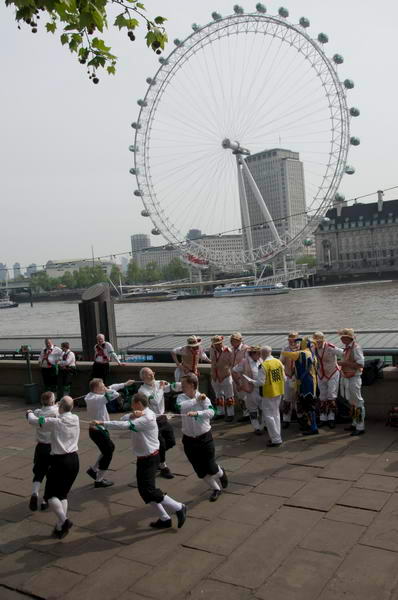I’m never quite sure that I want to photograph Morris Dancing. Partly I think because it seems to be such a popular subject with amateur photographers – the kind of event that gets listed under ‘photo opportunities‘ in the amateur magazines. Fortunately I don’t think these have got onto May Queens yet. But it does seem to be a general rule that whenever something is listed whether on a press release or elsewhere as a ‘photo-op’ it is almost certain to be boring. You, along with 27 other photographers are presented with someone else’s idea (almost always a word person’s idea) of what would make a good photograph, typically some posed group, and its always hard work – if not impossible – to make a different and more interesting picture.
Of course Morris isn’t like that, but it does come with lots of wacky coloured clothes, stripy waistcoats, flowery hats and knee-bells that make it ‘photogenic‘ – another of my least favourite words, committed as I am to the proposition that it’s photographers who make photographs. Photogenic just means more clichés to struggle against, and all too often my doggy paddle can’t breast the stream.
Not that I’m against Morris at all. It’s a great tradition and guys like Cecil Sharp and the others who recorded and resuscitated its dying embers at the turn of the nineteenth century did a great job. If I didn’t have a life and two left feet I’d happily join up and spend more time with them studying real ale. I’m even on record as saying that the stupidest, most arrogant and wrong-headed decision the English Arts Council ever made was not to fund Morris Dancers; “Over my dead body” on of its more illustrious leaders was reported to have said in a rare pause from shovelling money into the bottomless pit of London’s Royal Opera House.

Sword dancers at Embankment Steps, Westminster, London
The Westminster Day of Dance is rather a splendid event, organised by the “world famous Westminster Morris Men” who dress in tabards with a portcullis motif which makes me think of council employees (perhaps why I seem to have edited them completely out of the pictures I’ve put on line) though they do have a rather fine unicorn.
There were four locations where groups of dancers were putting in an early morning session before coming together in Trafalgar Square, and I decided that the River Thames would make for a more interesting London background, so started off at Embankment steps, with the view across the river, including the London Eye – see above. Shortly before the session ended I rushed down to Victoria Gardens, where I hoped that the Houses of Parliament and Rodin’s Burghers of Calais might form suitable backgrounds, though I didn’t really get either to work.
After a brief and pointless journey on the tube to photograph another event (on arrival I found it wasn’t starting until three hours after the time I’d found on the web) I went to see the Morris Men (and I think they were all men, although there are women Morris Dancers, following in the footsteps of the suffragette Esperance Working Girls Club of 1906) in Trafalgar Square, where they were competing rather successfully for the attention of tourists with Falun Dafa, celebrating its 16th anniversary and protesters against the slaughter of seals. The dancing continued at various sites around Westminster after lunch, but by then I was with the May Queens in rural suburbia.
There is a tendency for us to look back and see the interest in and revival of folk traditions – including both Morris and the May Queens around the end of the Victorian era as a conservative movement in political terms. There were actually strong links with the radical movements of the day both in the arts – the Arts and Craft movement – and in politics, including both socialism and the emancipation of women.